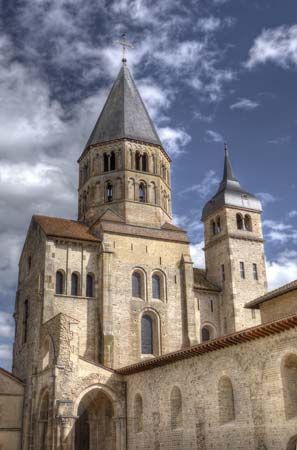Cluny
Cluny, town, east-central France, Saône-et-Loire département, Burgundy (Bourgogne) région, northwest of Mâcon. It owed its early importance to its celebrated Benedictine abbey, founded in 910 by Duke William the Pious of Aquitaine. The newly founded order introduced reform in a period of general monastic laxity, returning to a strict observance of the Benedictine Rule. The abbey, subject to no authority but that of the pope, developed a centralization previously unknown in the Benedictine order, and all Cluniac houses, called priories, remained subject to the mother abbey. The surrounding town of Cluny prospered from the prominence of the abbey and received a communal charter in 1090 from the abbot St. Hugh. Both town and abbey suffered during the religious wars of the 16th century, and the abbey was suppressed during the French Revolution and closed in 1790.
The Romanesque Basilica of St. Peter and St. Paul, built principally between 1088 and 1130, was the largest church in the world until the erection of St. Peter’s in Rome. Cluny’s basilica was in great part demolished in the early 19th century, but the ruins of the main southern transept, dominated by a great belfry tower, testify to its former glory. The economy of the modern town is based on the servicing of Cluny’s agricultural hinterland: there is a national stud farm, a livestock market, and woodworking industries. Pop. (2006 est.) 4,552.










